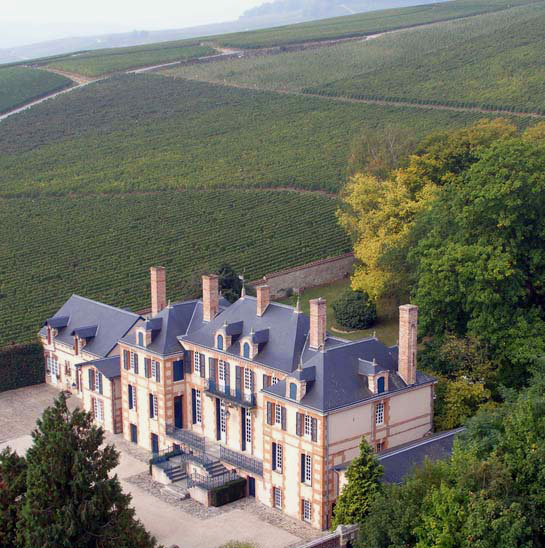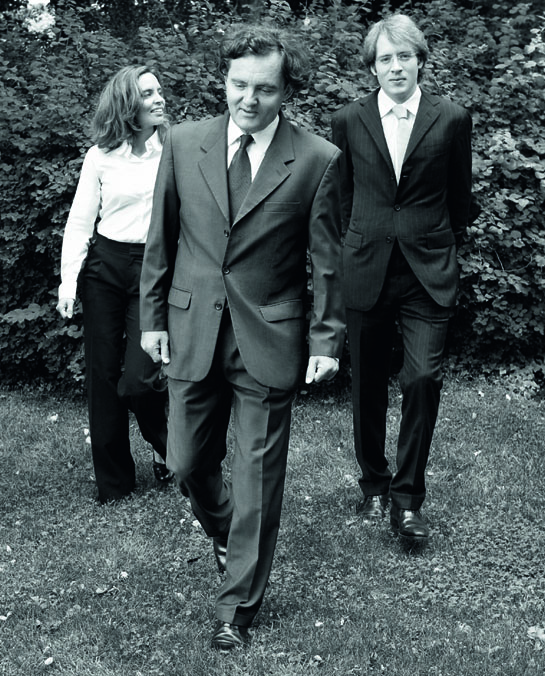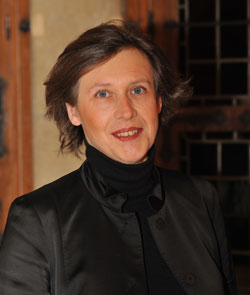The House of Taittinger: Where Family Endures and Impresses
Julie Whitlow

Taittinger La Marquetterie castle and vineyards
A recent trip through the Champagne was a family affair all around. We traversed the gorgeous back roads of the region in a rented car with our two daughters, ages 14 and 10. We were able to savor both views of the sunlit vineyards and a flight of great Champagnes in a visit to the Taittinger cellars in Reims. Evidence abounds that the family is once again the quintessence of the product which has only improved in depth, character, and quality in the past half dozen years. We were gratified by both the fantastic tasting and the generous Taittinger hospitality.
We arrived at the Taittinger cellars on a hot sunny August Monday to find family lore on full display. The girls were given an excellent crash course in Champagne that began with a slick and engaging video that wove the tale of the Taittinger ascent from 19th century wine merchants to an iconic powerhouse of French Champagne. When Pierre Taittinger bought the Château de la Marquetterie in 1932 from the wine house of Forest-Fourneaux , its vineyards of Chardonnay and Pinot Noir had long yielded the fruit originally cultivated by the early Benedictine innovators. Under the leadership of Pierre’s son, Franҫois, the cellars were established in 1945 in the damp and mysterious Gallo-Roman chalk caves, once part of the Abbey of Saint-Niҫaise. After the accidental death of Franҫois in 1960, his brother Claude maintained the momentum and the House of Taittinger became one of world-renown. The quality of the grapes and the relationships forged over generations between the family, the growers, and the winemakers secured Taittinger’s place as tenders of tradition.

Vitalie, Pierre-Emmanuel and Clovis Taittinger
The chalk caves were the perfect 12 degrees Celsius needed to age the wine despite the summer sun streaming through the skylights above. Our lovely guide Audrey knew to wear a woolen shawl as she led us down the winding staircases. As she reviewed the family lore she made scant mention of the demoralizing sale of Taittinger to the American Starwood Hotel group in 2005. That this sale embarrassed the Champagne industry is an understatement; the family’s repurchase in 2006, however, has clearly re-energized every aspect of the enterprise. Each detail exudes obvious reverence for Pierre-Emmanuel Taittinger’s management while his children, Clovis and Vitalie, clearly also have stature in the crucial areas of export and image. Other storied Champagne houses seemed forced to defend their independence from their parent LVMH conglomerate; in contrast, Taittinger can once again boast its family origins as aligned with the Champagne mystique.
Our tour of the caves gave the girls a first-rate lesson of the process of creating Champagne. When the yeast and sugar were first added to induce the “second fermentation” 400 years ago, the monks and wine makers were simply trying to understand why the colder climate of the Champagne region was creating those pesky bubbles. We saw the thousands of bottles that the cellar houses, from 75 cl bottles to the “big boys” of up to 15 liters, each stacked by hand in rack upon rack in the cool cellar. We were reminded that what has become known as the méthode champenoise includes adding just the right amount of yeast and sugar via this liqueur de tirage that creates a bottle full of sparkles. We saw the way that each bottle has to be turned a few degrees every two days for months, coaxing the yeasty sediment to the neck of the bottle before the cap and sediment are quickly removed, losing only a slight amount of the precious liquid.
We could hardly fathom that each bottle then had to be topped off with the liqueur d'expédition: a bit of calculated sugar and brandy added before the cork and wire cage are placed for the final years of aging. Thousands of bottles were each stacked in perfect formation, clearly demonstrating the amount of time and energy inherent in the process. While the necks of the bottles are now flash frozen to ease the removal of the sediment, the prestige cuvées are still treated by hand using the method that began four centuries ago with the alchemy of the brilliant blender, Dom Pérignon.
The sunlit tasting room was decorated with bottles designed with commissions from famous artists, another reminder that Taittinger’s image is crafted as carefully as its wines to exude both exclusivity and finesse. The 25 wine goblets lined up on the table assured us that we would be privileged with an array of tastes from Taittinger’s finest. Dominique Garréta, director of marketing and communications for Champagne Taitttinger, started us with the Brut La Franҫaise, a blend of all three grapes that come from at least 35 villages near Reims.

Dominique Garréta
Dominique confirmed what we were starting to realize: Champagne is made from the complex web of the family’s relationships with growers in the regions. The farmers and fertilizers, pruners and pickers all have a stake in the harvest; their labors contribute as much as the chalk, the soil, and the weather to the final product. As the Brut hits the glass, it is pale gold, dancing, peach and honey, a whiff of brioche.
We move to the Brut Prestige Rosé. It is bright pink, all raspberry and cherry. We ask about the growers, about organic methods. We learn about tradition, the family, the monks. The girls are angelic. Dominique presents them each with a velvet pouch with a key ring engraved with the Taittinger family crest. We are charmed and enjoying every drop. The Prélude is uncorked with a whisper, not a pop. Half Chardonnay, half Pinot Noir; the people of Avize, Le Mesnil sur Oger, Mailly, Bouzy, Ambonnay have all lent their labors. The winemaster has worked his magic. It is a silvery yellow; we proclaim the spice, peaches, and grapefruit. We ask about this year’s harvest. It is late: cold spring, hot summer; the grapes won’t be ready until October as the world of Champagne waits.
We end with the jewel of the Taittinger house: the Comptes de Champagne Blanc de Blancs. Named after Thibaud IV, Count of Champagne who brought back the red roses and vines from the Crusades, it is produced from the best Chardonnay Grands Crus. It comes from the first press in exceptional years when the soil and the sun and the growers and the winemaker make it so. Dominique pours five glasses this time. Mattea, the ten-year-old, calls it fruity. Marina, age 14, declares it pungent. We relish the first taste. The wine is slightly sweet and silky, laced with flowers. It is golden and sublime.
When it’s over, Dominique presents us each with a bottle of Brut Milléseme. We follow her red convertible to a local restaurant where we eat shrimp and spring rolls; the girls try lamb tagine and fois gras. We drink what Dominique calls an “immense Champagne,” Les Folies de la Marquetterie. It is deep gold, toast and fruit; it is delicious with the food. Our day at Taittinger is complete.
There is no doubt that we will we will always remember our trip to Reims and the day that we touched the chalk that feeds the vines of Champagne. It is clear that the Champagne of Taittinger has only improved due to the commitment of the family, their reverence for history, and their constant innovation. We will shelve those two bottles of Taittinger Brut that Dominique gave us and will likely open them on milestones in the girls’ lives. And we will enjoy and savor this unique luxury and revel in its passage from field to flute.
